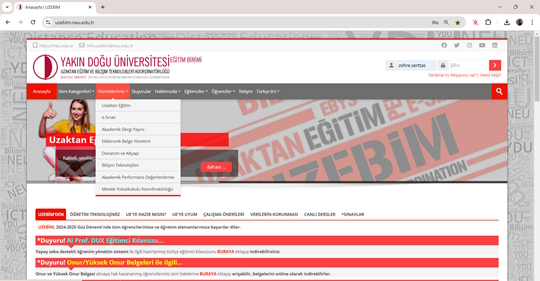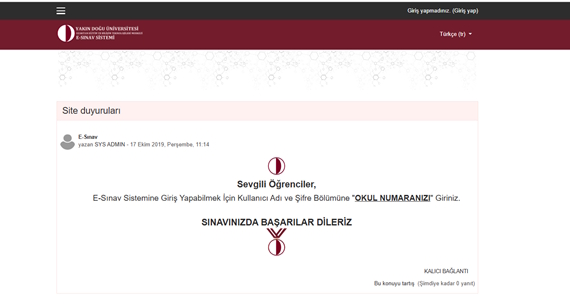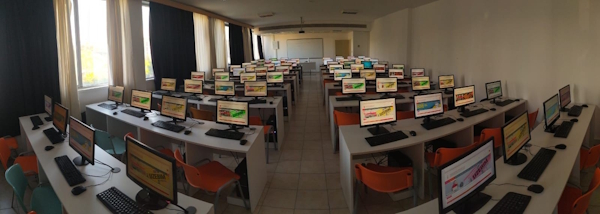In recent years, education has undergone a remarkable transformation, embracing technology to meet the evolving needs of students and educators. At Near East University, the introduction of electronic examinations (e-exams) has redefined how assessments are conducted, offering practical and efficient solutions that benefit both learners and academic staff. E-exams not only offer efficient and eco-friendly alternatives to traditional assessments but also enhance the transparency and accuracy of evaluations through automated grading systems. With robust data analytics, our academic teams gain valuable insights to further optimize learning outcomes.
The e-exam system is managed by the Distance Education and Information Technologies Coordination Office, established under the university’s Education Unit.
First implementations
E-exams were first introduced during the 2019-2020 academic year, initially as a pilot program for exemption exams in courses such as Computer Technologies. This trial phase involved 476 students, who successfully accessed their exams through the e-exam platform. The system’s quick grading feature allowed students to view their results immediately after completing the tests, marking the start of a new era in assessment methods at the university.

The success of the pilot program paved the way for broader implementation across various faculties including Faculty of Dentistry, Faculty of Medicine, and Vocational School of Health Services. By the end of the 2019-2020 academic year, all midterm, final, and makeup exams for asynchronous courses under the coordination of the Common Courses Unit were conducted through the e-exam system. A total of 12,890 students participated in these exams, significantly reducing paper usage. In fact, transitioning to e-exams saved around 30,000 sheets of paper per term, highlighting the university’s dedication to sustainable practices.

Adapting to Challenges: The Role of E-Exams During the Pandemic
The onset of the COVID-19 pandemic during the spring term of 2020 underscored the importance of digital solutions in education. Near East University’s e-exam system became an essential tool for ensuring uninterrupted learning and evaluation during this challenging period. With all courses and exams shifting online, maintaining exam security was a top priority.
To address potential concerns, the university integrated the Safe Exam Browser into its e-exam platform. This software prevented students from accessing unauthorized resources or opening additional tabs during their exams. Detailed video tutorials and manuals were provided to help students install and use the browser effectively. These measures ensured that exams were conducted fairly and securely, even in remote settings.
Throughout the pandemic, more than 28,000 students used the e-exam system across all faculties. This success demonstrated the reliability and scalability of the system, which continues to support a wide range of courses and assessments.

Expanding the Use of E-Exams
Today, the e-exam system is an integral part of the university’s assessment framework. It is actively used in faculties such as Engineering, Dentistry, Medicine, Pharmacy, and Communication, among others. Exams are conducted in computer labs equipped with modern technology, ensuring a smooth experience for students and staff alike.
Two main platforms power the e-exam system:
- neu.edu.tr: Supports exemption exams, English proficiency tests, and international scholarship assessments.
- neu.edu.tr: Used by faculties for undergraduate and graduate exams, offering tailored solutions for various disciplines.
The Benefits of E-Exams

- Instant grading reduces the time required for result publication.
- Streamlined processes simplify preparation compared to traditional exams.
Cost Savings and Sustainability
- Eliminates the need for paper and printing, reducing costs and environmental impact.
- Saves natural resources, with 30,000 sheets of paper conserved per term.
Flexibility and Accessibility
- Remote access allows students to take exams from various locations with internet connectivity.
- Supports multimedia-enhanced questions, offering dynamic assessment formats.
Enhanced Security
- Features like biometric verification and randomized questions prevent malpractice.
- Secure platforms ensure data integrity and exam fairness.
Customization and Insights
- Personalized exams adapt to individual needs.
- Analytics provide insights into student performance and question difficulty.
Challenges and Limitations of E-Exams
Despite its numerous advantages, the e-exam system faces several challenges:

- System failures, internet instability, or device malfunctions can disrupt exams.
- Infrastructure gaps, such as power outages and unequal access to reliable technology, may disadvantage some students.
User Challenges:
- Technological inexperience and accidental errors, such as closing the exam unintentionally, pose barriers for some users.
Assessment Limitations:
- Open-ended and practical skills assessments are less suited to automated evaluation.
Student Perspectives
As part of Near East University’s vision for digital transformation, e-exams offer both students and academic staff a modern and efficient method of assessment. To better understand the strengths and areas for improvement of the system, a survey was conducted with participation from students across multiple faculties. The faculties with the highest participation included Dentistry, Medicine, Pharmacy, and Engineering.
The survey reflects the experiences of 750 volunteer students who have taken e-exams, shedding light on the system’s benefits and challenges. The e-exam system stands out with its benefits in time management, eco-consciousness, and objectivity in evaluation processes. 85% of survey respondents stated that e-exams provide a modern and flexible learning environment. Additionally, the majority emphasized the importance of its environmentally friendly nature.
What students appreciate: A majority of students highlighted the immediate feedback provided by e-exams and the environmentally friendly approach as significant advantages. The speed of result calculation and the elimination of paper use were among the most appreciated aspects.
“The instant feedback from e-exams makes the learning process much more efficient.”
“The fact that no paper is used and it promotes an eco-friendly approach is truly impressive.”
Challenges highlighted: Some students pointed out technical issues and insufficient time as challenges. Problems with internet connectivity or device malfunctions were among the factors negatively impacting their e-exam experience.
“Technical issues during the exam can be very stressful.”
“Devices need to be more stable; there’s room for improvement in this area.”
Looking Ahead
Incorporating feedback from students and academic staff, Near East University is committed to continuously improving its e-exam system. By addressing technical challenges such as internet connectivity and device stability, and by enhancing accessibility measures, the university aims to further streamline the assessment process.
The insights gathered from student surveys highlight the importance of modernizing digital tools and ensuring a seamless examination experience. Immediate feedback and eco-friendly practices will continue to serve as cornerstones of the system, while additional efforts will focus on optimizing user support and addressing specific needs, including flexibility in exam durations.
As Near East University continues to embrace technological advancements, the e-exam system exemplifies innovation in education. By balancing practicality with sustainability, the system remains a benchmark for modern academic assessments, setting a global standard for institutions striving toward digital excellence.